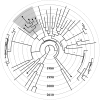Decreasing prevalence of transmitted drug resistance among ART-naive HIV-1-infected patients in Iceland, 1996-2012
- PMID: 28649306
- PMCID: PMC5475329
- DOI: 10.1080/20008686.2017.1328964
Decreasing prevalence of transmitted drug resistance among ART-naive HIV-1-infected patients in Iceland, 1996-2012
Abstract
Introduction: Resistance to antiretroviral drugs can complicate the management of HIV-1 infection and impair control of its spread. The aim of the current study was to investigate the prevalence and transmission of HIV-1 drug resistance among 106 antiretroviral therapy (ART)-naïve patients diagnosed in Iceland (1996-2012). Methods: HIV-1 polymerase sequences were analysed using the Calibrated Population Resistance tool. Domestic spread of transmitted drug resistance (TDR) was investigated through maximum likelihood and Bayesian approaches. Results: Among ART-naïve patients, the prevalence of TDR to any of the following classes (NRTIs, NNRTIs and PIs) was 8.5% (95% CI: 4.5%- 15.4%): 6.6% to NRTIs, 0.9% to NNRTIs, and 1.9% to PIs. The most frequent NRTI mutation detected was T215C/D (n=7, 5.7%). The only NNRTI mutation detected was K103N (n=1, 0.9%). PI mutations detected were M46I (n=1, 0.9%) and L90M (n=1, 0.9%). Six patients harbouring T215C/D, were linked in a supported phylogenetic cluster. No significant association was found between TDR and demographic or risk groups. Trend analysis showed a decrease in the prevalence of TDR (1996-2012, p=0.003). Conclusions: TDR prevalence in Iceland was at a moderate level and decreased during 1996-2012. Screening for TDR is recommended to limit its local spread and to optimize HIV-1 therapy. Abbreviations: ART: Anti-retroviral therapy; ARV: antiretroviral; ATV/r: atazanavir/ritonavir; AZT: azidothymidine; BEAST: Bayesian evolutionary analysis by sampling trees; CI: confidence interval; CPR: calibrated population resistance; CRF: circulating recombinant form; d4T: stavudine; EFV: efavirenz; FET: Fishers' exact test; FPV/r: fosamprenavir/ritonavir; HET: heterosexual; IDU: injection drug use; IDV/r: indinavir/ritonavir; LPV/r: lopinavir/ritonavir; MSM: men who have sex with men; M-W: Mann-Whitney U test; NFV: nelfinavir; NNRTIs: non-nucleoside reverse transcriptase inhibitors; NRTIs: nucleoside reverse transcriptase inhibitors; NVP: nevirapine; PIs: protease inhibitors; pol: polymerase gene; SDRM: surveillance drug resistance mutation; SQV/r: saquinavir/ritonavir; TDR: transmitted drug resistance.
Keywords: BEAST; Phylogeny; resistance; transmission; trend.
Figures


Similar articles
-
Surveillance of HIV-1 pol transmitted drug resistance in acutely and recently infected antiretroviral drug-naïve persons in rural western Kenya.PLoS One. 2017 Feb 8;12(2):e0171124. doi: 10.1371/journal.pone.0171124. eCollection 2017. PLoS One. 2017. PMID: 28178281 Free PMC article.
-
Incidence of transmitted antiretroviral drug resistance in treatment-naive HIV-1-infected persons in a large South Central United States clinic.Ann Pharmacother. 2014 Apr;48(4):470-5. doi: 10.1177/1060028013519246. Epub 2014 Jan 28. Ann Pharmacother. 2014. PMID: 24473489
-
Prevalence and persistence of transmitted drug resistance mutations in the German HIV-1 Seroconverter Study Cohort.PLoS One. 2019 Jan 16;14(1):e0209605. doi: 10.1371/journal.pone.0209605. eCollection 2019. PLoS One. 2019. PMID: 30650082 Free PMC article.
-
Transmitted Drug Resistance in Antiretroviral Therapy-Naive Persons With Acute/Early/Primary HIV Infection: A Systematic Review and Meta-Analysis.Front Pharmacol. 2021 Nov 24;12:718763. doi: 10.3389/fphar.2021.718763. eCollection 2021. Front Pharmacol. 2021. PMID: 34899288 Free PMC article. Review.
-
Lopinavir/ritonavir: a review of its use in the management of HIV infection.Drugs. 2006;66(9):1275-99. doi: 10.2165/00003495-200666090-00012. Drugs. 2006. PMID: 16827606 Review.
Cited by
-
Epidemiological surveillance of HIV-1 transmitted drug resistance among newly diagnosed individuals in Shijiazhuang, northern China, 2014-2015.PLoS One. 2018 Jun 5;13(6):e0198005. doi: 10.1371/journal.pone.0198005. eCollection 2018. PLoS One. 2018. PMID: 29870534 Free PMC article.
-
Drug Resistance Mechanism of M46I-Mutation-Induced Saquinavir Resistance in HIV-1 Protease Using Molecular Dynamics Simulation and Binding Energy Calculation.Viruses. 2022 Mar 28;14(4):697. doi: 10.3390/v14040697. Viruses. 2022. PMID: 35458427 Free PMC article.
-
Transmitted drug resistance and transmission clusters among HIV-1 treatment-naïve patients in Guangdong, China: a cross-sectional study.Virol J. 2021 Sep 6;18(1):181. doi: 10.1186/s12985-021-01653-6. Virol J. 2021. PMID: 34488793 Free PMC article.
-
Treatment Management Challenges in Naïve and Experienced HIV-1-Infected Individuals Carrying the M184V Mutation.Viruses. 2024 Aug 30;16(9):1392. doi: 10.3390/v16091392. Viruses. 2024. PMID: 39339868 Free PMC article. Review.
References
-
- The directorate of health in Iceland. 2015. [cited 2015 September 2]. Available from: www.landlaeknir.is.
-
- Statistics Iceland: the centre for official statistics in Iceland. 2016. [cited 2016 February 11]. Available from: www.statice.is.
-
- Sallam M, Esbjörnsson J, Baldvinsdóttir G, et al. Molecular epidemiology of HIV-1 in Iceland: early introductions, transmission dynamics and recent outbreaks among injection drug users. Infect Genet Evol. 2017;49:157–163. - PubMed
-
- Indridason H, Gudmundsson S, Karlsdottir B, et al. Long term nationwide analysis of HIV and AIDS in Iceland, 1983-2012. J AIDS Clin Res. 2014;5:387.
-
- Palella FJ Jr., Delaney KM, Moorman AC, et al. Declining morbidity and mortality among patients with advanced human immunodeficiency virus infection. HIV Outpatient Study Investigators. N Engl J Med. 1998;338:853–860. - PubMed
LinkOut - more resources
Full Text Sources
Other Literature Sources
Molecular Biology Databases
Research Materials
Miscellaneous
